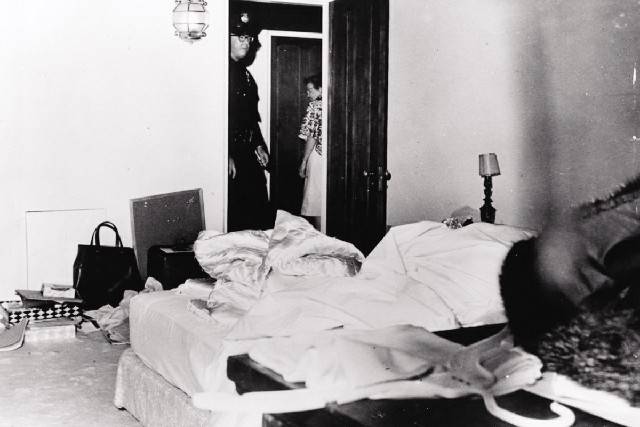
This photograph was captured in the days following the death of Marilyn Monroe on August 5, 1962. It shows one of her bedrooms, where her housekeeper found her naked, unconscious, and with a telephone in her hand and a bottle of pills at her side.
After a brief investigation, Los Angeles police concluded that her death was “caused by a self-administered overdose of sedative drugs and that the mode of death is probable suicide.”
Marilyn Monroe was born Norma Jeane Mortenson in Los Angeles on June 1, 1926. Her mother was emotionally unstable and frequently confined to an asylum, so Norma Jeane was reared by a succession of foster parents and in an orphanage. At the age of 16, she married a fellow worker in an aircraft factory, but they divorced a few years later. She took up modeling in 1944 and in 1946 signed a short-term contract with 20th Century Fox, taking as her screen name Marilyn Monroe. She had a few bit parts and then returned to modeling, famously posing nude for a calendar in 1949.
She began to attract attention as an actress in 1950 after appearing in minor roles in The Asphalt Jungle and All About Eve. Although she was onscreen only briefly playing a mistress in both films, audiences took note of the blonde bombshell, and she won a new contract from Fox. Her acting career took off in the early 1950s with performances in Love Nest (1951), Monkey Business (1952), and Niagara (1953). Celebrated for her voluptuousness and wide-eyed charm, she won international fame for her sex-symbol roles in Gentlemen Prefer Blondes (1953), How to Marry a Millionaire (1953) and There’s No Business Like Show Business (1954). The Seven-Year Itch (1955) showcased her comedic talents and features the classic scene where she stands over a subway grating and has her white skirt billowed up by the wind from a passing train. In 1954, she married baseball great Joe DiMaggio, attracting further publicity, but they divorced eight months later.
In 1955, she studied with Lee Strasberg at the Actors Studio in New York City and subsequently gave a strong performance as a hapless entertainer in Bus Stop (1956). In 1956, she married playwright Arthur Miller. She made The Prince and the Showgirl–a critical and commercial failure–with Laurence Olivier in 1957 but in 1959 gave an acclaimed performance in the hit comedy Some Like It Hot. Her last role, in The Misfits (1961), was directed by John Huston and written by Miller, whom she divorced just one week before the film’s opening.
By 1961, Monroe, beset by depression, was under the constant care of a psychiatrist. Increasingly erratic in the last months of her life, she lived as a virtual recluse in her Brentwood, Los Angeles, home. After midnight on August 5, 1962, her maid, Eunice Murray, noticed Monroe’s bedroom light on. When Murray found the door locked and Marilyn unresponsive to her calls, she called Monroe’s psychiatrist, Dr. Ralph Greenson, who gained access to the room by breaking a window. Entering, he found Marilyn dead, and the police were called sometime after. An autopsy found a fatal amount of sedatives in her system, and her death was ruled probable suicide.

After a brief investigation, Los Angeles police concluded that her death was “caused by a self-administered overdose of sedative drugs and that the mode of death is probable suicide.”
Marilyn Monroe was born Norma Jeane Mortenson in Los Angeles on June 1, 1926. Her mother was emotionally unstable and frequently confined to an asylum, so Norma Jeane was reared by a succession of foster parents and in an orphanage. At the age of 16, she married a fellow worker in an aircraft factory, but they divorced a few years later. She took up modeling in 1944 and in 1946 signed a short-term contract with 20th Century Fox, taking as her screen name Marilyn Monroe. She had a few bit parts and then returned to modeling, famously posing nude for a calendar in 1949.
She began to attract attention as an actress in 1950 after appearing in minor roles in The Asphalt Jungle and All About Eve. Although she was onscreen only briefly playing a mistress in both films, audiences took note of the blonde bombshell, and she won a new contract from Fox. Her acting career took off in the early 1950s with performances in Love Nest (1951), Monkey Business (1952), and Niagara (1953). Celebrated for her voluptuousness and wide-eyed charm, she won international fame for her sex-symbol roles in Gentlemen Prefer Blondes (1953), How to Marry a Millionaire (1953) and There’s No Business Like Show Business (1954). The Seven-Year Itch (1955) showcased her comedic talents and features the classic scene where she stands over a subway grating and has her white skirt billowed up by the wind from a passing train. In 1954, she married baseball great Joe DiMaggio, attracting further publicity, but they divorced eight months later.
In 1955, she studied with Lee Strasberg at the Actors Studio in New York City and subsequently gave a strong performance as a hapless entertainer in Bus Stop (1956). In 1956, she married playwright Arthur Miller. She made The Prince and the Showgirl–a critical and commercial failure–with Laurence Olivier in 1957 but in 1959 gave an acclaimed performance in the hit comedy Some Like It Hot. Her last role, in The Misfits (1961), was directed by John Huston and written by Miller, whom she divorced just one week before the film’s opening.
By 1961, Monroe, beset by depression, was under the constant care of a psychiatrist. Increasingly erratic in the last months of her life, she lived as a virtual recluse in her Brentwood, Los Angeles, home. After midnight on August 5, 1962, her maid, Eunice Murray, noticed Monroe’s bedroom light on. When Murray found the door locked and Marilyn unresponsive to her calls, she called Monroe’s psychiatrist, Dr. Ralph Greenson, who gained access to the room by breaking a window. Entering, he found Marilyn dead, and the police were called sometime after. An autopsy found a fatal amount of sedatives in her system, and her death was ruled probable suicide.


